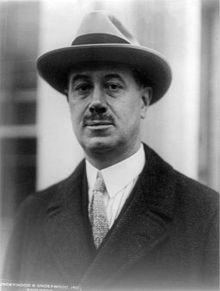
The Tribune Tower is a 463-foot-tall (141 m), 36-floor neo-Gothic skyscraper located at 435 North Michigan Avenue in Chicago, Illinois, United States. The early 1920s international design competition for the tower became a historic event in 20th-century architecture. Built for Chicago Tribune owner Robert R. McCormick, since 2018 it has been converted into luxury residences and in 2023 won a Driehaus Prize for architectural preservation and adaptive reuse from Landmarks Illinois.
WGN-TV is an independent television station in Chicago, Illinois, United States. Owned by Nexstar Media Group, it is sister to the company's sole radio property, news/talk/sports station WGN. WGN-TV's studios are located on West Bradley Place in Chicago's North Center community; as such, it is the only major commercial television station in Chicago which bases its main studio outside the Loop. Its transmitter is located atop the Willis Tower in the Loop.
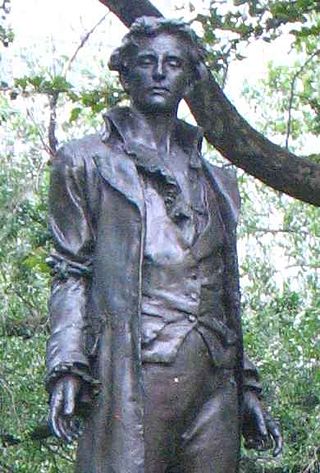
Nathan Hale was an American Patriot, soldier and spy for the Continental Army during the American Revolutionary War. He volunteered for an intelligence-gathering mission in New York City but was captured by the British and executed. Hale is considered an American hero and in 1985 was officially designated the state hero of Connecticut.

Water Tower Place is a large urban, mixed-use development comprising a 758,000 sq ft (70,400 m2) shopping mall in a 74-story skyscraper in Chicago, Illinois, United States. The mall is located at 835 North Michigan Avenue, along the Magnificent Mile. It is named after the nearby Chicago Water Tower, and is owned by affiliates of Brookfield Property Partners. As reported by the Chicago Suntimes, Brookfield Property Partners handed the keys to the project back to their lender, MetLife, owing to numerous retail vacancies following the closing of Macy's and the impact of COVID and increasing crime along the Magnificent Mile.

WGN is a commercial AM radio station in Chicago, Illinois, featuring a talk radio format. WGN's studios are in the Chicago Loop, while the transmitter is in Elk Grove Village. WGN also features broadcasts of Chicago Blackhawks hockey and Northwestern University football and basketball.

Robert Rutherford "Colonel" McCormick was an American lawyer, businessman and anti-war activist.

Tribune Broadcasting Company, LLC was an American media company which operated as a subsidiary of Tribune Media, a media conglomerate based in Chicago, Illinois. The group owned and operated television and radio stations throughout the United States, as well as full- or partial-ownership of cable television and national digital subchannel networks.
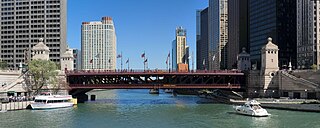
The DuSable Bridge is a bascule bridge that carries Michigan Avenue across the main stem of the Chicago River in downtown Chicago, Illinois, United States. The bridge was proposed in the early 20th century as part of a plan to link Grant Park (downtown) and Lincoln Park (uptown) with a grand boulevard. Construction of the bridge started in 1918, it opened to traffic in 1920, and decorative work was completed in 1928. The bridge provides passage for vehicles and pedestrians on two levels. An example of a fixed trunnion bascule bridge, it may be raised to allow tall ships and boats to pass underneath. The bridge is included in the Michigan–Wacker Historic District and has been designated as a Chicago Landmark.

The McCormick Freedom Museum was the first museum in the United States dedicated to the First Amendment by the McCormick Foundation. It was open from April 11, 2006, until March 1, 2009. The museum offered visitors an interactive experience focused on first amendment rights which include freedom of speech, freedom of religion, freedom of the press, assembly and petition. It was located on Michigan Avenue along the Magnificent Mile next to the historic Tribune Tower.

Chicago Vocational High School is a public 4–year vocational high school located in the Avalon Park neighborhood on the south side of Chicago, Illinois, United States. Opened in 1941, the school is operated by Chicago Public Schools district.
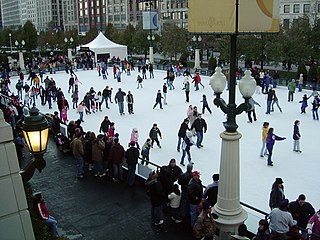
McCormick Tribune Plaza & Ice Rink or McCormick Tribune Plaza is a multi-purpose venue within Millennium Park in the Loop community area of Chicago, Illinois, in the United States. On December 20, 2001, it became the first attraction in Millennium Park to open. The $3.2 million plaza was funded by a donation from the McCormick Tribune Foundation. It has served as an ice skating rink, a dining facility and briefly as an open-air exhibition space.
Andrew Nicholas Rebori was an American architect who was a member of the Chicago school of architecture.
The McCormick family of Chicago and Virginia is an American family of Scottish and Scotch-Irish descent that attained prominence and fortune starting with the invention of the McCormick Reaper, a machine that revolutionized agriculture and established the modern grain trade by beginning the mechanization of the harvesting of grain. Through the McCormick Harvesting Machine Company and later, the International Harvester Company and other investments, the McCormicks became one of the wealthiest families in America. The name became ubiquitous in agriculture starting in the 19th century and the press dubbed the McCormicks the "Reaper Kings". Later generations expanded into media and publishing, finance, and real estate. Various family members were well known as civic leaders. They are descended from an influential leader of modern agriculture, inventor Robert McCormick Jr. (1780–1846), and Mary Ann "Polly" Hall of Steeles Tavern, Virginia. The family is Presbyterian.

401 North Michigan is a 35-story skyscraper in the Streeterville area of Chicago, built in 1965 at 401 North Michigan Avenue, along the north bank of the Chicago River. It was designed by Bruce Graham and Natalie de Blois in the international style. Along with the Tribune Tower and Wrigley Building, it forms the southern gateway to Chicago's famous Magnificent Mile. The building was built atop the site of a cabin belonging to Chicago's first permanent resident, Jean Baptiste Pointe du Sable. In reference to du Sable, the large plaza adjacent to the building has been named Pioneer Court.
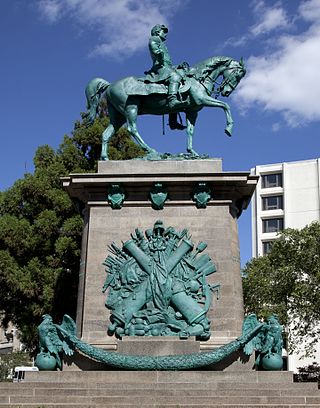
Major General George B. McClellan is an equestrian statue in Washington, D.C. that honors politician and Civil War general George B. McClellan. The monument is sited on a prominent location in the Kalorama Triangle neighborhood due to efforts made by area residents. The statue was sculpted by American artist Frederick William MacMonnies, a graduate of the École des Beaux-Arts whose best known work is a statue of Nathan Hale in New York City. MacMonnies was chosen to design the statue following a lengthy competition organized by a statue commission, led by then Secretary of War William Howard Taft. The monument was dedicated in 1907, with prominent attendees at the ceremony including President Theodore Roosevelt, New York City mayor George B. McClellan Jr., politicians, generals and thousands of military personnel.

American Revolution Statuary is a group of fourteen statues in Washington, D.C., which honor men whose actions assisted the Thirteen Colonies in their fight against the Kingdom of Great Britain in the American Revolutionary War. They are spread throughout the city, except for the four statues in Lafayette Square, across from the White House, that honor some of the foreign heroes from the war. Some of the statues are located in prominent places, while others are in small parks or stand alone in front of buildings. All of the statues are owned and maintained by the National Park Service, an agency of the United States Department of the Interior. The statuary was collectively listed on the National Register of Historic Places (NRHP) in 1978 and the District of Columbia Inventory of Historic Sites the following year. In addition, most are also contributing properties to historic districts listed on the NRHP.

Captain Nathan Hale is a bronze statue of Nathan Hale (1755-1776), a schoolteacher from Connecticut, who enlisted in the Continental Army during the American Revolutionary War. He was stationed in Boston, but was later transferred to the New York City area. While in New York, Hale acted as a spy against the Kingdom of Great Britain's army. He posed as a teacher and was able to cross enemy lines to obtain military information. He left the area and before he could return home, his cousin, a Loyalist, informed the British about what Hale had done. He was captured and sentenced to death, with the hanging occurring the following day. While Hale was on the gallows, he gave a speech which ended with his famous quote: "I only regret that I have but one life to lose for my country."

Tribune East Tower is a 1,442 ft (439.5 m) mixed use supertall tower to be constructed on the eastern edge of the Tribune Tower property, in the Streeterville area of Chicago. The building plans were approved on May 8, 2020. When completed, the tower will be the second-tallest building in Chicago, after the Willis Tower, and one of the tallest buildings in the Western Hemisphere. Construction is to begin in the first half of 2024 and to be completed by September 2027.

WGN America was an American subscription television network that operated from November 9, 1978 to February 28, 2021. The service was originally uplinked to satellite by United Video Inc. as a national feed of Chicago independent station WGN-TV, making the station's programming available to cable and satellite providers throughout the United States as the second nationally distributed "superstation".

The Ulysses S. Grant Monument is a presidential memorial in Chicago, honoring American Civil War general and 18th president of the United States, Ulysses S. Grant. Located in Lincoln Park, the statue was commissioned shortly after the president's death in 1885 and was completed in 1891. Several artists submitted sketches, and Louis Rebisso was selected to design the statue, with a granite pedestal suggested by William Le Baron Jenney. At the time of its completion, the monument was the largest bronze statue cast in the United States, and over 250,000 people were present at the dedication.


